KNOW THE TERRIFIC TREKKING TRIPS IN INDIA.

Ever wondered how astounding it would be to get on top of a summit and see the rest of the world below you? Is it possible to triumph over Nature’s labyrinth and be the ultimate mighty conqueror? Yes… Trekking can give you just exactly that prodigious sense of victory!
The diverse Indian landscape provides numerous opportunities for fanatical trekkers, not only for those within the country but also from abroad, to scout for its multitude of mountains, rivers, valleys, forests and green fields, across the length and breadth of this vast country. Trekking serves many good purposes besides recreational; physically getting close to the unknown geographical facets of Mother Earth helps in being more conscious of the delicate environment through which we traverse, meditatively and spiritually enlightening our inner conscience, and becoming aware of the cultural significance attached to the wilderness.
Presenting here, about 20 of the top-drawing trekking excursions to be undertaken at least once in a lifetime! So put on those boots, choose your season and destination, get ready for a remarkable multi-day adventure; and come back only to narrate your own ‘trek tale’ and ‘philosophical experience’.
1. Chadar trek – Frozen Zanskar Gorge (75 km, 9 days)
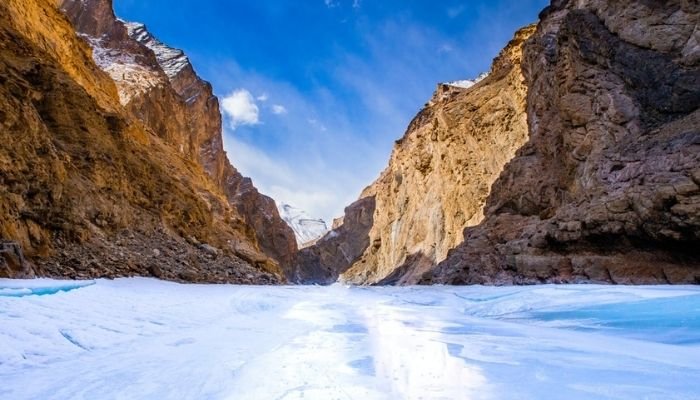
The most unrivalled and most perplexing of all winter treks in the gigantic snow mountains of the Great Himalayan ranges, has to be none other than a precarious walk on a frozen Zanskar river in Leh, beyond question!
There is really nothing to beat the excitement of walking on solidified ‘blankets’ of ice, while passing through unimaginably stunning gorges; and quite equally nothing to beat the challenge of a sub-zero temperature expedition, sometimes as low as -35° C, while longing to see just one golden ray of sunlight.
Chadar trek can feel like as if having been transported to a remote and lost world. It is recommended only between the months of January to February, for this is when the river gets iced up, making it feasible for walking. It especially requires being alert before taking steps forward as the spotlight of this journey is the dynamic nature of the ice which may form, break away and change its hues, quite frequently; and hence spontaneous changing of tracks by trekkers is necessary to avoid parts of the river where there are no icy sheets.
On rarest of occasions, it may even be possible to spot an animal or two – like an ibex or a snow leopard! However, the major spectacle of this trek is a magnificent frozen waterfall – the largest in the region! This location is like a real life fantasy and clicking a picture here could become a priceless possession forever!
2. Markha Valley – Tea House Trek (65km, 9 days)

This is essentially a route along the Markha river that flows within the Hemis National Park, in Leh district – so it should be of no surprise to expect some wildlife, predominantly the mountain dwelling goats, hares, wolves, marmots and red foxes!
Markha trek majestically alternates between dry, barren mountain-scapes, and patches of greenswards with small nomadic settlements. It is filled with many distinctive moments… like crossing some very high altitude ‘passes’, wading waist-deep through river waters, capturing breathtaking views of the pyramid peaks of Mt. Kang Yangtse, K2 and Stok Kangri, and reaching sapless canyons with brightly colored prayer flags flapping in the winds… One also gets to watch grazing yaks, witness traditional farming, visit old Buddhist monasteries and ruined forts.
It is fondly known as the ‘tea house trek’ for the number of ‘home-stay’ options generously offered by the villagers in their simple yet appealing mud homes, where they willingly serve hot and refreshing cuppas, and local food. Such an accommodative feature further allows one to immerse into the ‘Tibetan’ flavors existing in the Valley.
This is one of the treks where the heart wants to tirelessly plod along to eagerly unlock the ravishing sceneries hidden behind every continuous chain of sky-scraping mountains. Markha valley surely leaves indelible impressions in the mind!
3. Phugtal Gompa Trek – Incredible Cliff Monastery (25km, 3 days)
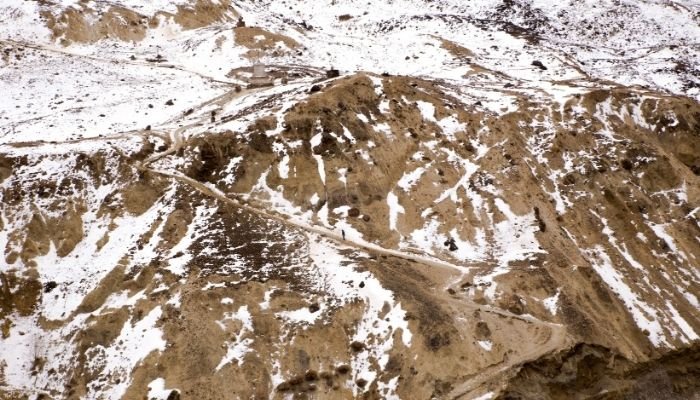
Phuktal monastery (Gompa) is curiously nestled high up in the solitude of the Lungnak Valley of Zanskar Ranges, in Ladakh. The way its structures are clustered around the mouth of a cave like a beehive on the frontal face of a cliff, truly make up for an enchanting sight!… this coupled with the prospect of a tributary of Lungnak river, flowing down below a ravine right in front of the cave, doubly adds on to its charm!
The alluring tour demands navigating through steep, narrow and winding paths, in the lap of the eroded slopes of the yellowish brown alps; en-route which one has to cross over a few wooden bridges and shall find a few white-colored chortens or stupas.
This 12th century monastery is currently inhabited by some young monks who conduct prayers in rooms with antiquated frescos, and run a monastic school for children from nearby villages. They ever readily recount inspiring chronicles of those who have lived in the Gompa, and earnestly keep their timeless customary practices alive by celebrating all their festivals. Phugtal is the only establishment that spruces up life in this part of the valley.
The non-snowy months in the middle of the year, when the routes clear would be the best time to plan a visit to the offbeat ‘Cave Gompa’ which was supposed to have been incepted more than 2550 years ago.
4. Tarsar Marsar Trek – Haven of Prettiest Lakes (48 km, 7 days)

Can dreamy verses pulled out from a fairytale ever be turned into reality??
“Flying into the blue skies… riding on the wings of clouds… prancing over velvety meadows… running around apple orchards… playing with wild flowers… star gazing in the dark of night…”
No amount of such lyrical descriptions can justify the spellbinding beauty of Tarsar-Marsar in Kashmir! Metaphorically, a Garden of Eden; surely nobody can even paint a picture as beautiful as this!
Tarsar and Sundarsar are two of the prettiest alpine lakes, found amidst the prettiest of ridges – the Kolahoi mountains in the Himalayas. The ethereal ‘sparkle’, from the seemingly ‘mirror-polished’ surfaces of these sapphire-blue lakes, is just irresistible to the fervid wanderlusters. Marsar is another snow-fed lake but often concealed by overhanging clouds. It allows only a few magical seconds to admire its loveliness when the clouds momentarily disperse and close back again.
Camping beside these glacial lakes, one can drift into deep trances of surreal imaginations. Those who come here find it extremely difficult to tear away from this place at a subconscious level; after all this is the finest romantic date ever with Nature that can leave them awestruck for many, many days!!!
ALSO READ: 15 Best Motorcycle Road Trips in India For Every Passionate Biker
5. Hampta Pass Trek – Best in Monsoons (35 km, 5 days)
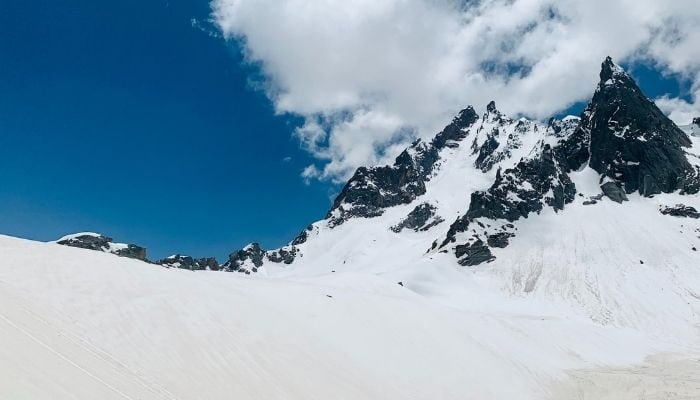
One of the easiest treks to go on during the Indian monsoons, Hampta Pass in the Pir Panjal range, in Himachal, delights beginners and experts alike. The season ensures pleasantly cool weathers along with light enjoyable showers.
Starting with verdant pastures from Hampta village in Kullu valley that gradually rise to merge with the spiked mountains, to tall pinewood tree forests, to snow-dressed peaks while scaling the Pass, and ending at the arid domains of Lahaul & Spiti… it treats trekkers with a dramatic variety of landscapes, nicely rolled together into a single package.
Although it is already a path well trodden, it still constantly lures people, for the travel ends on a high note at ‘Chandra Tal’ {Moon Lake}. Setting a camp for a night’s stay next to this crescent-shaped lake feels like an icing on the cake, rightly deserved after the long and arduous journey!
Tourists can completely let themselves sync with the harmonious environment at this point, so as to bring in a renewed sensation of peace and tranquility upon their psyche.
6. Prashar Lake Trek – Secret Between the Hills (15 km, 2 days)
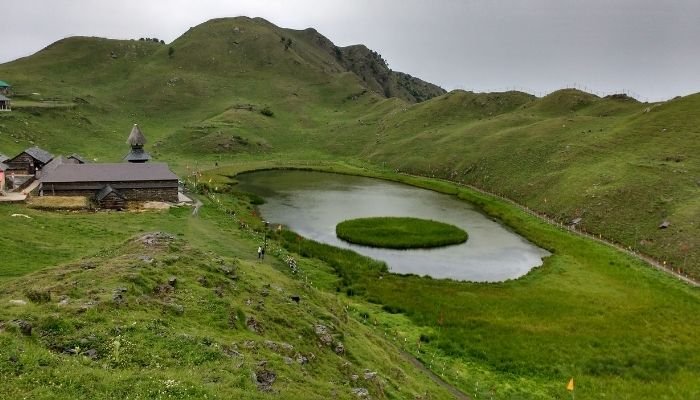
How about going on a ‘treasure hunt’? The sheer thrill of discovering a ‘hidden gem’… far on the hills and deep into the forests… can whip up enough enthusiasm in anybody, to set out on a thirsty mission to find the very same!
A short trek to the blue-water Prashar Lake, encircled by the grand Dhauladhar range in Himachal Pradesh, is nothing short of finding a precious jewel amidst boundless stretches of uninhabited land; because it seems as though this pristine and picturesque reservoir lies in strict confidentiality entrusted between the hills.
Decked in swathes of white snowflakes during winters, whereas radiating expansive vistas of emerald greens the rest of the year, this is a jaunt which makes for the perfect family weekend getaway that is good to be marked anytime on the calendar.
The awesome mountainous trail takes you through an undulating array of dense oak and cedar forests, gurgling rivulets, beds of rhododendrons, cute little hamlets, and glades of grasslands. On reaching a low lying misty basin cradling the unblemished waterpool, it is nearly impossible to miss a sublime pagoda styled temple complex belonging to the 13th century, on the banks of this lake. It is now easy to apprehend as to why a mystic called Sage Prashar must have cherry-picked this spot to seek transcendental wisdom!
While soaking in the joy of camping on this seraphic site, we ought to realize that we need to show more gratitude and compassion towards life in general, for we are only a tiny speck in the infinite universe!
7. Miyar Valley Trek – Crystal Green Glacial Lakes (60km, 8 days)

If you are looking out for an escapade into a no-man’s-land, far from the cries of civilization, then Miyar Valley, nicknamed as the Yosemite of India, is where to turn to!
Beginning at Udaipur Village near Manali, the dale of Miyar is quietly located in the north-eastern side of Lahaul, with Kang La Jot at the end of the Valley, which is one of the extreme points in India.
It is considered to be a relatively easy-to-do trek as compared to other Himalayan safaris, comprising of hiking on flattened surfaces for the most part or very gentle gradients if at all any. The quaint valley consistently shifts between panoramas of viridescent pasturage fed on by horses and cows, and tanned brown sierras.
After lazing around orchid fields and lounging about bouldery riverbeds, a serendipitous encounter with a series of seven glacial lakes dazzling in crystalline green can throw you into an unforeseen state of bewilderment!
8. Beas Kund Trek – Amazing River Crossings (30 km, 3 days)

River Beas – the potion of sustenance that flows full of vim and vigour through the hilly Kullu region, is exuberantly surrounded by prepossessing and unpolluted environs. A meandering trail across such an ecosystem laden with deodar, maple, walnut, fir and birch trees; also home to extraordinary medicinal shrubs, wild type flora (mushrooms, strawberries, roses, marigolds, thistles, ferns) & fauna (brown bears, musk deers, monals), and shepherds’ encampments; in search of its source will precisely take you to the hallowed ‘Beas Kund’.
Beas Kund attaches a legendary significance to itself viz., revered Rishi Vyas, used to engage in his daily routine rituals of meditation and bathing at this very pond, and wrote the epic Mahabharat.
Be that as it may, the impressive trip takes you wandering via a lush Solang Nala, the venerable Manu Temple and the grassy meadows of Dhundi and Bakarthach, along with plenty of daring river crossings. It also gives a lucky chance to get up close with Manali’s famous snow clad mountains such as Friendship Peak, Mt. Indrasen, Hanuman Tibba and Deo Tibba.
This is one of the treks that can be defined to be ‘as pretty as a picture’ from start to end without a pause; specially with the innumerable waterfalls cascading down from glaciers to join babbling brooks – what an incredible sight to behold!
9. Valley of Flowers Trek – Colorful Palette of Blossoms (37 km, 6 days)

‘The promised land’ beckons… and then follows the temptation to cross the threshold and walk into the gates of heaven!! “Valley of Flowers” in the Nanda Devi Biosphere Reserve (recognized by UNESCO) is every inch that heavenly abode on earth!
A sweetness in the air emanates from the unsullied Valley where purplish bell flowers dance to the breeze, rosy-pink geraniums glow with dew-drops, pearly-white daisies keep smiling, lemony-yellow poppies whisper to each other, lavender primulas cheerfully gaze, scarlet rhododendrons spread warmth, crimson knotweeds stand tall to please, orangish sorrels sway with the wind and so on.
The exotic colors of the blossoms enclosed by verduous mountain-rises, combined with melodious chirping of birds, soothing rhythm of creeks, and gently caressing zephyrs… impart a blissful flavor and fragrance to the Vale. Sometimes thick fogs blurring the horizon or slight drizzles get included within the captivating ‘frame’. It is highly recommended to visit between the months of July and September when the Valley opens up in full bloom with its 500-odd species of high altitude flowering plants.
Valley of Flowers is unrivalled to any other in the country and irrefutably proves to be a royal feast for the eyes. A memoir of this visit in your “travel diaries” will definitely be the best in record to recall for many years thereafter.
10. Roopkund Trek – Mysterious Human Skeletons (53 km, 8 days)
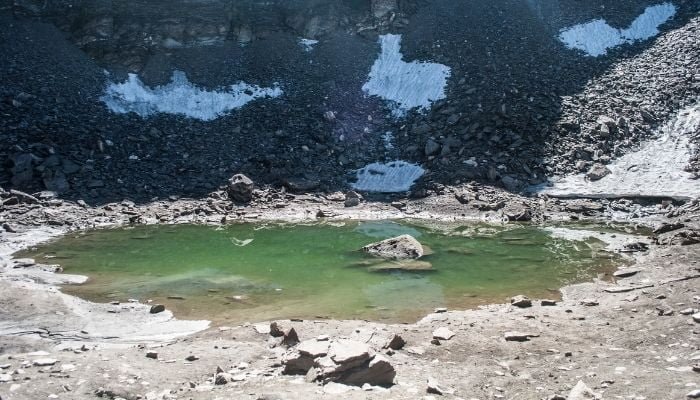
A trek to Roopkund Lake or the “Mystery Lake” or the “Skeleton Lake” is as spooky and dangerous as it sounds!
Resting on a very high altitude of 15,700 ft, Roopkund lies in the ‘Trishul’ massif of Chamoli district in Uttarakhand. The lake has kindled the curiosity of anthropologists over the years owing to the uncanny presence of hundreds of skeletons of humans by the lakeside; the carbon dating of which suggests that it could be as old as belonging to 850 AD!
Other than that, being covered in heaps of snow for most of the time, it is recommended only for the expert trekkers as it consists of too many steep inclines. It is also replete with weather hazards such as sudden blizzards, snowstorms, avalanches, and fogs entirely obscuring visibility.
The heavy dose of Roopkund trudging begins at a small bourg named Lohajung, then moves into miles and miles of thick coniferous jungles giving way to the two twin Bugyals (pasturelands) – Ali and Bedni; to climbing on limitless extents of snow covered acclivity. It is said that the apex of Kedarnath, Kedar Dome, Chaukhamba, Nanda Ghunti and Neelkanth mountains can be seen from here.
Finally… descending down a slippery concave depression to get to the pellucid Kund at its bottom marks the triumphant end of a footslogging roller-coaster!
11. Gaumukh Trek – Source of Ganga (42 km, 7 days)

The most sought after spiritual getaway in India is none other than the one to the very source of the Ganga, i.e. Gaumukh.
The Ganga, highly regarded and worshipped as a sacred river Goddess of purity, fertility, benevolence and salvation, comes into existence from the glacial meltwaters of the “Gangotri”, which is present in Uttarkashi district of the Garhwal Himalayas. ‘Gaumukh’ is found at the base of the Gangotri glacier at 13,200 ft, and so called due to its resemblance to the shape of a cow’s mouth or snout. Many a people believe in the divine grace of watching the ‘Bhagirathi’ {the head stream of the Ganges} gushing out of the snout in full force.
The pious trek takes off at the Gangotri Temple, a famous pilgrimage stop in “Char Dham”; proceeding from here one goes into the Gangotri National Park, a natural habitat for ‘bharals’ or the blue sheep. There on, many kilometers of desolate and denuded valley lead up to the destined ‘place of origin’. On the way, ‘pilgrims’ are able to wholly perceive the towering pinnacles of Mt. Shivling and Mt. Meru, that gleam like gold under the brilliant rays of the morning sun.
Above Gangotri glacier, at the foot of Mt. Shivling, lies ‘Tapovan’ – an upland retreat carpeted with flowery and stream-perforated meadows.
12. Har ki Dhun Trek – Mythical Trail (56 km, 7 days)
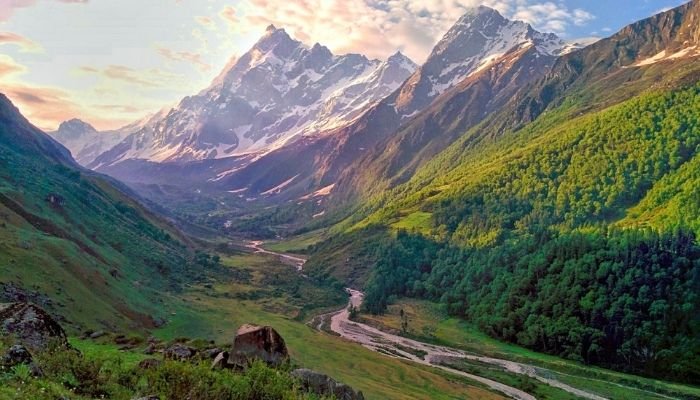
A valley that naturally changes its color tones with the changing seasons renders a hypnotizing effect on one’s mental faculties… such is the marvel of ‘Har ki Dhun’ present in the Garhwal ranges at the foothills of the grandiloquent Swargarohini peak.
The winters that see the chill of white snowpacked ‘nullahs’… transform to invigorating spirits of pastel springs… turn to calming verdures of alpine vegetation in summers… that become staid russet shades during autumns. This splendid characteristic bestows Har ki Dhun with the epithet “Valley of Gods”!
As per Indian mythology, the Pandavas of the Mahabharat took the passage through Har ki Dhun during their ascent to heaven.
Apart from this, this is a fantastic trek-voyage that goes through orthodox villages that may be more than 2000 years old; therefore it gives the unusual benefit of interacting with the natives who are nearly unacquainted with the accessories of modern life and hold onto to their timeworn culture with contentment. One of them – Osla, adorably snuggled in between apple trees, on a mountain slope, attracts everyone with its charming wooden houses, and is celebrated till date for its ancient Someshwar Temple.
13. Goecha La Trek – Mesmerizing Kanchenjunga (90 km, 10 days)
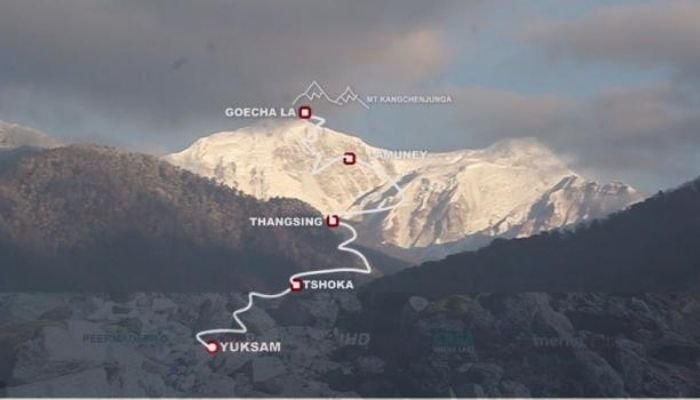
Neatly tucked in the eastern Himalayas, India’s most immaculate state of Sikkim, has time and time again astonished folks with its multiple layers of enrapturing beauteousness. Trailblazing along Goechala, a lofty high mountain-pass, only to be enveloped by the massive aura of the world’s third highest peak, the Kanchenjunga, can have a profound impact on the inner-self, the memories of which linger on continually!
Initiated at the prominent town of Yuksom; diehard shutterbugs would be gladly engrossed with an endless sequence of cultivated farmlands, as well as rickety suspension bridges on the way to Sachen. Here on, losing oneself in the bewitching fable-like thickets of rhododendrons is inevitable; just as to the arresting twilight scenes of sunrise at the backdrop of the Kanchenjunga range, farther up the Dzongri viewpoint; and thence to the cloud-kissed lea areas of Thansing & Lamunay whose only tenants maybe some mules and yaks!
Striding further, brings one to climb the strenuous pass, before heading back on the same circuit.
Goechala has found itself a top spot in the favorite list of ‘must-do treks’ recently because of two valued reasons – first, it can get a person to the closest proximity possible to our neighbor Nepal, and second, the amicable and hospitable humans of Sikkim can literally sweep anyone off their feet with their superlative courteous manners!
14. Dzukou Trek – Excellent Naga Heritage (35 km, 5 days)
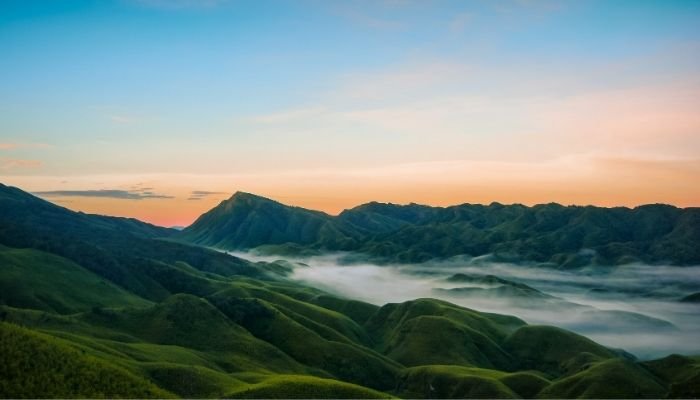
Turning towards the province of the Hornbill Festival, takes you to the petite state of Nagaland; rich with commendable, time-honored heritage and folklore of its Naga tribes!
Dzukou Valley, bordering Nagaland near Manipur, behind Japfu peak, has been publicized as a trekking destination only in the last few years; yet has quickly moved upwards in the popularity meter. Dubbed as the ‘Valley of Flowers of the North-East’, Dzukou has earned an unrivalled tag of being ‘unique’ in this part of India.
This merryful rambling involves negotiation through gleeful bamboo-woods, serpentine streamlets of clear waters, and a spellbinding realm of rolling hillocks wrapped in a luxuriant lawn-like turf. Basically suited to be a year-round trek, the flowering season between June and September can be particularly bewitching with the unfurling of a mind-blowing spectrum of flowers over the valley. This period also grants visitors with a chance to see the exclusive ‘Dzukou lily’ that is endemic to this territory.
All the more, the most striking and peculiar character of the valley is that it is located in the bowl of a crater of a defunct volcano!
Dzukou is definitely ‘A Walk to Remember’!
15. Sandakphu Trek – View of Mt. Everest (65 km, 7 days)

Sandakphu, the highest elevation of West Bengal, at the edge of the Singalila National Park in Darjeeling district, churns out immense interest among skilled mountaineers from all over the globe!
The reason being that this is the only trek which guarantees wide fields of vision of four of the tallest mammoth peaks of the world – Mt. Everest, Mt. Lhotse, Mt. Makalu and Mt. Chomo Lonzo – all piercing above 8000 ft in height, on one side; and the charismatic Kanchenjunga batch on the other side, otherwise labeled as ‘The Sleeping Buddha’ owing to its appearance. All these snowy mountains look gorgeously ornamental with a gilt-bronze shine during sunsets.
Besides reveling in showers of rhododendrons and giant magnolias, those fortunate will be able to fascinate themselves by spotting the rare red pandas and pangolins too!
Specifically, the highlight of Sandakphu trekking is that it allows joyful crisscrossing between villages on the Indo-Nepal borderlines. Additionally, casual mingling with the localite Lepcha tribal community, known to be friendly, helps in appreciating the place better.

Good writing and a great boon for who loves trekking.